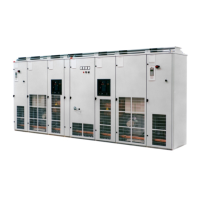Chapter 3 – Twelve–Pulse Parallel Configurations with DCS 600
II F2
3 - 4 DCS 600 Manual for 12 – Pulse Operation
Monitoring and fault
signals
In the 12 – pulse
parallel master
It is recommended to set
MOTOR NOM CURRENT (99.03) = [50%] of
the rated motor current. This will influence the scaling of the fol-
lowing signals available in the 12 – pulse parallel master:
ARM CUR ACT SL 12 – pulse slave motor current
(2.21) 100 % = MOTOR NOM CURRENT (99.03)
ARM CUR ALL
12 – pulse motor current; sum of the
(2.22) motor currents of both the master and
the slave converter.
100 % = 2 x MOTOR NOM CURRENT (99.03)
CONV CUR ALL
12 – pulse motor current; sum of the
(2.23) converter currents of both the master
and the slave converter.
100 % = 2 x CONV NOM CURR (4.05)
In both the mas-
ter and the slave
converter
In both the master and the slave converter, the current control
status signals of both converters are available:
CTRL STAT MA current control state of the master
(3.09)
CTRL STAT SL
current control state of the slave
(3.10)
B0: 1 == CURR CONTROL STAT (6.01) not zero
B1: Sign of CUR REF 3
(3.12)
B2: 1 == Bridge changeover is active
In 12 – pulse parallel mode, the master converter monitors the
slave current. If the currents of both converters differ more than the
permitted difference programmed to parameter DIFF CUR LIMIT
(47.04)
, for more than the number of control cycles (3.3 ms at 50
Hz) programmed to parameter
DIFF CUR DELAY (47.05), the fault
66 CURR DIFF (12 – pulse current deviation) is activated.
If the 12 – pulse communication timeout has elapsed without re-
ceiving a valid DDCS message from the 12 – pulse master, the
slave activates the fault
67 12P COMM (12 – pulse communication
fault).
Note: The same timeout monitoring is done by the 12 – pulse
master, too.

